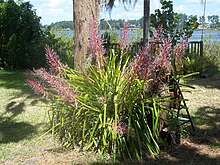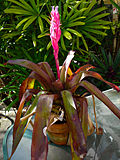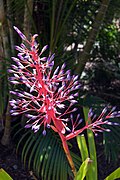
The Bromeliaceae are a family of monocot flowering plants of about 80 genera and 3700 known species, native mainly to the tropical Americas, with several species found in the American subtropics and one in tropical west Africa, Pitcairnia feliciana.

Tillandsia is a genus of around 650 species of evergreen, perennial flowering plants in the family Bromeliaceae, native to the forests, mountains and deserts of the Neotropics, from northern Mexico and the southeastern United States to Mesoamerica and the Caribbean to central Argentina. Their leaves, more or less silvery in color, are covered with specialized cells (trichomes) capable of rapidly absorbing water that gathers on them.

Puya is a genus of the botanical family Bromeliaceae. It is the sole genus of the subfamily Puyoideae, and is composed of 226 species. These terrestrial plants are native to the Andes Mountains of South America and southern Central America. Many of the species are monocarpic, with the parent plant dying after one flower and seed production event.

Catopsis berteroniana, commonly known as the powdery strap airplant or the lantern of the forest, is an epiphytic bromeliad thought to be a possible carnivorous plant, similar to Brocchinia reducta, although the evidence is equivocal. Its native range is from southern Florida to southern Brazil. It generally grows on the unshaded twigs of trees, and has been shown experimentally to trap more insects in its tank than other bromeliads of comparable size. There are several other species in the genus, none of which is believed to be carnivorous.
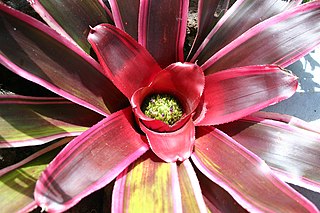
Neoregelia is a genus of epiphytic flowering plants in the family Bromeliaceae, subfamily Bromelioideae, native to South American rainforests. The genus name is for Eduard August von Regel, Director of St. Petersburg Botanic Gardens in Russia (1875–1892).

Billbergia is a genus of flowering plants in the family Bromeliaceae, subfamily Bromelioideae.

Puya raimondii, also known as queen of the Andes (English), titanka and ilakuash (Quechua) or puya de Raimondi (Spanish), is the largest species of bromeliad, its inflorescences reaching up to 15 m (50 ft) in height. It is native to the high Andes of Bolivia and Peru. It was once hypothesized to be a protocarnivorous plant.

Aechmea blanchetiana, also known as orangeade bromeliad is a common bromeliad species found in the restingnas vegetation along the Atlantic Coast which is part of the Atlantic forest biome in eastern Brazil. This plant grows from the State of Bahia south to Espírito Santo. It is common worldwide in tropical and sub-tropical regions for its use as an ornamental plant.

Wittrockia is a genus of plants in the family Bromeliaceae, subfamily Bromelioideae.

Fascicularia is a monotypic genus of flowering plants in the pineapple family Bromeliaceae, subfamily Bromelioideae. The genus name is from the Latin fasciculus (bundle) and arius.
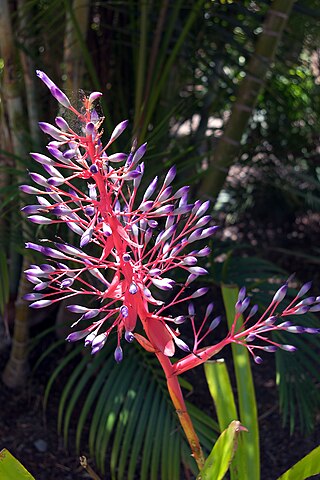
Portea petropolitana is a plant species of the genus Portea, in the family Bromeliaceae.
Orthophytum magalhaesii is a plant species in the genus Orthophytum. This species is endemic to Brazil.

Quesnelia testudo is a species of bromeliad in the genus Quesnelia.

Portea alatisepala is a plant species in the genus Portea.

Portea kermesina ('kermesina'=crimson) is a plant species in the genus Portea in the bromeliad family.

Alcantarea imperialis is a species of bromeliad in the genus Alcantarea. This species is endemic to Brazil.
Portea fosteriana is a plant species in the genus Portea.

Portea grandiflora is a plant species in the genus Portea endemic to northeastern Brazil.
Portea silveirae is a plant species in the genus Portea.

Vriesea hieroglyphica is a plant species in the genus Vriesea.
